In many lives of accomplishment, there is a tool that has played a central, enabling role, and in turn has become a symbol of that life and those accomplishments. For King Arthur this tool was, without a doubt, his magical sword, Excalibur, drawn from a rock at the suggestion of The Lady of the Lake. No doubt, Arthur came to love Excalibur, for this trusty tool helped him unite diverse kingdoms into a whole. Similarly, many of my life’s accomplishments can, in large measure, be ascribed to a shovel. I too came to love this shovel, and named it Excalibur for its magic, but unlike Arthur’s Excalibur, mine was not drawn from a rock, nor announced by Lake Maidens. Rather, in the mid-1970s, it was taken from a barn by an employee of Tall Timbers Research Station and given to me as a gift. Even when I took possession, this shovel was probably already close to a century old, and it had seen a good deal of use, its blade polished and thinned by a great deal of resistant, abrasive soil. Its normal-length shaft had a defect, a knot, with which it had survived close to a century, but soon after I took possession, the shaft broke to half its original length. I smoothed the broken end, not immediately realizing that this “failure” had created the perfect tool for the work I had begun doing, and that I now owned The World’s Greatest Shovel, a tool heaven-sent for digging deep holes to study ant nests. Perhaps this shortened shovel reflected Arthur’s experience too, for the story goes that he broke the first Excalibur in battle and was presented the second Excalibur by the Lady of the Lake, and with this, he finished his life’s work.
You may smirk at my claim that Excalibur is The World’s Greatest Shovel, so I hasten to explain. Let’s start with the quality of construction. This is not a cheap 20th century industrial shovel stamped from a uniform sheet of steel, given a partial length-wise crease to make the blade rigid, its collar bent into an ill-fitting cylinder to receive a hickory shaft. No, the thickness of my shovel gradually increases from the lower cutting edge to the upper step. This means that unlike mass-produced shovels, the business end is thin and sharp, and the upper step-end so stiff that it needs no additional stiffening bends. Next, the collar (or socket) of Excalibur is an elegantly curved, hollow piece welded to the blade. At the upper end of the collar is a hole with a bolt that binds the assembly firmly to the wooden shaft. In the early years, I sometimes used the shovel to collect invertebrates in the sand flats of the Gulf of Mexico, but the salt water rusted the collar to the point where I had the machine shop repair this damage by welding (the bright metal in the image below). I never used the shovel in salt water again.
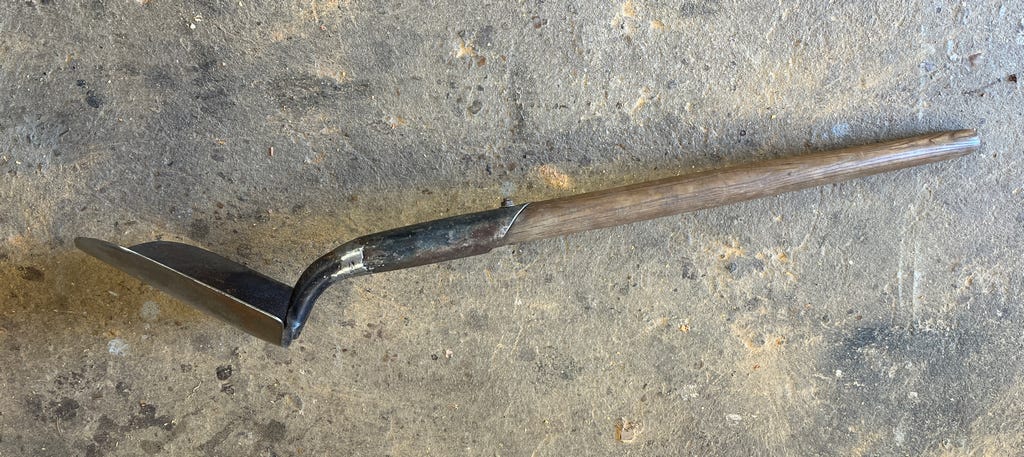
Over about four decades, I used this shovel to excavate and census hundreds of ant nests of about 40 species, most of them in the sandhills of the Apalachicola National Forest south of Tallahassee, and some in the desert of southern California. This may not sound like a big deal, but let’s take an example of a typical excavation of a Florida harvester ant, Pogonomyrmex badius.
The average nest is about two meters (6 feet) deep, but in order to collect all the members of the colony or to excavate a metal cast of the nest, you have to dig a pit to one side of the nest and dig into the nest (or expose the cast) laterally, starting at the top, layer by layer. In this way, you expose every cubic centimeter of the three-dimensional space occupied by the nest and are unlikely to miss anything. The pit must be large enough to work in, so, at least one meter by about two meters in horizontal section, and eventually at least two meters or more deep (four to five cubic meters). You will be most comfortable working on the nest between knee-height and chest height. Working below foot level is very tricky and likely to end without satisfaction.
In the 80s, I began a series of ant biology studies that frequently required a lot of digging. I discovered that I really liked to dig holes (go figger), and that the holes had to be neat and rectilinear. In my opinion, neat holes made neat research results. No, I am not kidding. The sloppier and messier the pit, the more likely you are to miss part of the ant colony. I’ve seen it many times. Purely amateur. Not good.

At a density of about 1.5, these four cubic meters of sand weigh about five to six metric tons. All this sand must be tossed far enough away from your pit so that it doesn’t slide back in on your head. I should also mention that occasionally the sides of the pit cave in and bury you knee deep, and you have to toss out an additional couple of tons of sand. And don’t forget that you have to refill the pit when you are done.

Now the beauty of the short-handled shovel comes into view. When you are more than waist deep in a hole measuring about one by two meters, you can’t swing a cat, much less a shovel with a normal length shaft. There simply isn’t room. You can’t simply lift each shovelful and deposit it just over the edge of the pit, but have to toss it far enough beyond the edge so that it won’t slide back. This means that the sand has to be tossed with considerable velocity. If you try to do this with a normal shovel, the long shaft will collide with the sides of the pit, stopping in mid-swing, caving in part of the wall as the shovel’s load falls back to the bottom of the pit, or flies back in your face. But with Excalibur, the tossing motion can be executed even in a deep pit whose edge is a meter above your head.
Even then, a two-handed swing is difficult, so I developed a one-handed swing, like so: grip the shovel mid-shaft with the upper end of the shaft lined up with your forearm and pressed against the underside of your elbow. Now you can swing upward unimpeded in a small space, and as the shovel comes even with your head, you grip the collar with your other hand just above the blade and accelerate the load up and out, onto the accumulating piles of sand away from the edge of the pit. In my prime, I could dig a hole deeper than I was tall in about an hour.
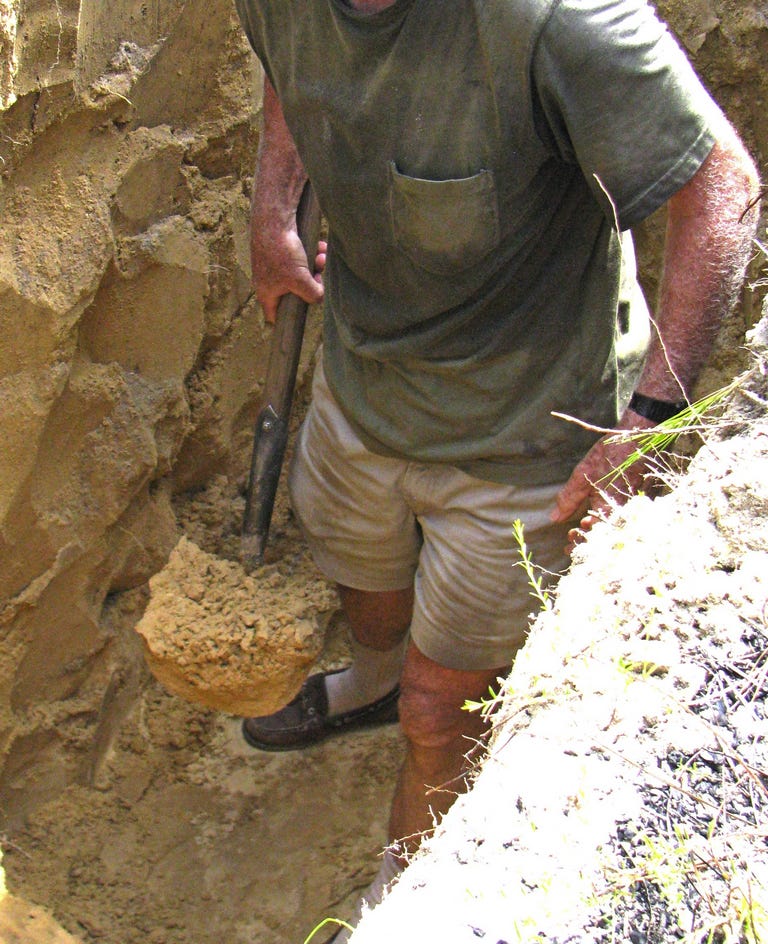
Once you get this motion right, you will feel like a ballet dancer, and a coherent mass of sand will be on its aerial way to the pile forming around your pit. With a little extra boost, the shovelful will land on the far side of the pile’s ridge, and then there is no danger that it will slide back down onto your head or your sweaty, sticky back.

In the mid 80s, an ant that was only active during the winter, Prenolepis imparis, attracted my attention, because from late March until the first of November there was no sign of the ant above ground. Naturally, I wondered what they did underground for seven months. I marked a bunch of nests so I could locate them even during the summer, then polished up Excalibur and started digging. I soon discovered that the nests were very deep, and because I had not yet perfected the one-hand throw, I got my students to help with the digs. We rigged up a bucket-hauling system with those at the bottom of the pit filling the bucket and those at the surface hauling it up. The deepest nests were about four meters deep so that we needed a ladder to enter and escape. Thankfully, the surface guys never got the idea of absconding with the ladder, so we got the work done and it was sociable, fun and amazing to discover that ants only three to four millimeters long could dig nests that deep. We also discovered that the colony lived without feeding for seven months by drawing on the huge amounts of fat stored in the bodies of the young workers. It was one of the first major projects in which Excalibur served valiantly and effectively.

In 1988 or so, I had the bright idea of characterizing the annual cycle of harvester ants in relation to their colony size. I figured I could excavate (at least) two small, two medium and two large colonies on four dates through a year. This would reveal how colonies changed during the year and during their growth. With my assistant Natalie, we dug up 36 colonies ranging from a hundred to 11,000 ants, whose nests ranged from about a meter to 3.2 meters (ten feet) deep. In this project, we thus moved about 250 metric tons of sand out of pits and then back in. This wasn’t so bad in the winter and spring, but in mid-summer and fall, it was debilitating work for both of us. We created what pitiful shade we could with a beach umbrella. It wasn’t much help.



The love of digging up ant nests seems to have been contagious, for a number of my students, both graduate and undergraduate, did research projects that involved digging up many nests ranging from small to large, but the undoubted champion was Christina whose Ph.D. research was based on about 90 excavated harvester ant nests (most of them were replanted). After apprenticing with Excalibur, she acquired a shovel of a much more modest lineage, but it was good enough to do the job anyway.
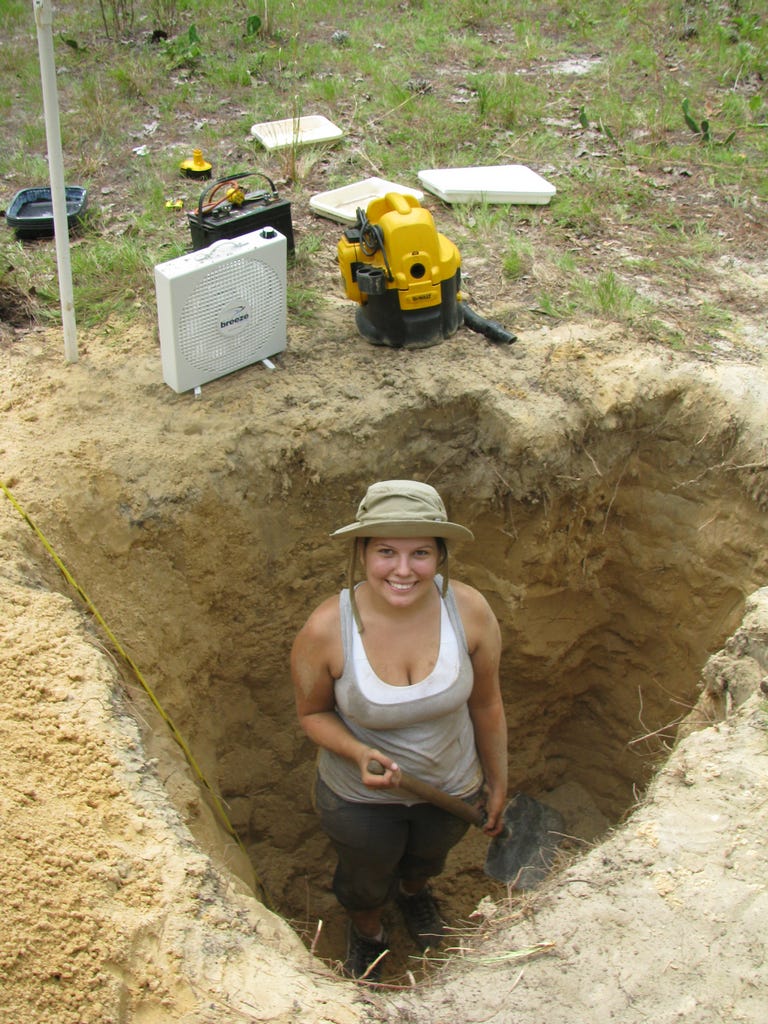
The thinness of the edge that made Excalibur great at chopping through fairly substantial roots in this pine forest also made the shovel vulnerable to injury, forming a short crack at the cutting edge, sometimes making the metal bend, dulling the edge and exacerbating the crack. To prevent the crack from propagating, I sawed off a centimeter or two of the edge and resharpened it. Thus Excalibur’s blade became shorter and shorter over several decades. This made the shovel’s maximum load gradually smaller—-Excalibur and I aged in parallel and faded in sync. I am not sure I could still dig a hole over my head in an hour—- Excalibur and I have been reluctant to run the test.

Taking stock of all the digging Excalibur and I have done during my career, especially after ant nest architecture and census took on greater importance, I estimate that I have dug up well over 200 nests (and this doesn’t include over 90 fire ant nests where Excalibur shared the work with a post-hole digger), some as shallow as one meter, some deeper than three or four meters. In the process, Excalibur and I have moved close to 1000 metric tons of sand out of pits and back. In the process I have learned an amazing amount about ant biology. Arthur’s Excalibur helped him unify kingdoms, and mine helped me unify a lot of ant natural history.
When Arthur lay dying, he requested that Excalibur be cast back into the lake. Although his knight initially disobeyed his command, when he finally did, a woman’s hand rose from the lake to catch Excalibur. I wish I could submit my Excalibur to a similar fate, but I have neither a knight for the casting, nor a lake with a resident woman to receive it. Just as Arthur owed his magical sword so much, so do I owe my wonderful shovel. My Excalibur deserves as dignified an end as Arthur’s, but what shall it be?
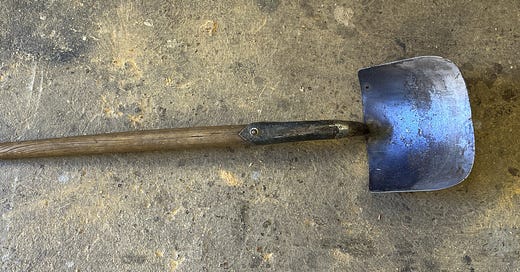



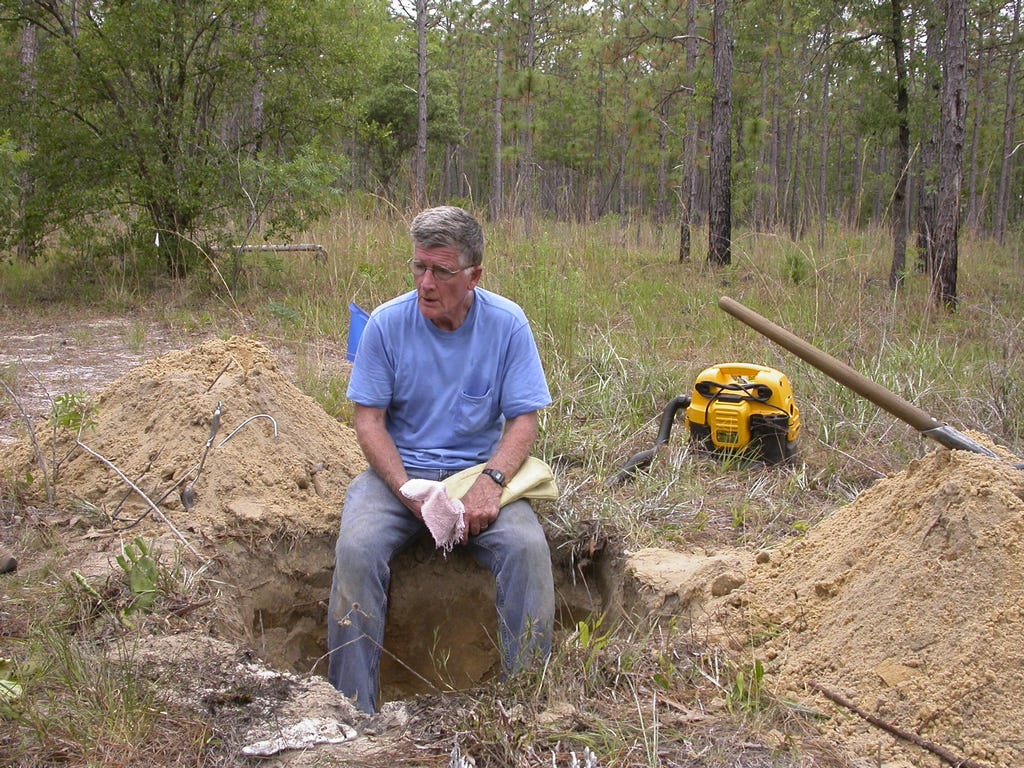
Thank you, Walter, for providing this essay on your tools and techniques for studying the nests of ants in the sandy soil where you worked. I like how you share the historical and structural details of your shovel, the way you did your excavations, and what it felt like to do this work. When I look at the photo that shows you standing in a deep (ca. 15 feet?) hole, though, I think this looks mighty risky... what happens if a wall collapses and you are buried to your waist, chest, neck, or more?
Please know that after reading this essay, I admire even more than before your pioneering studies of the soil nests of ants. Thank you, too, for writing you books, which make your findings easy to find!
We just have to ask the shovel where it would like to end up. The answer might be surprising.